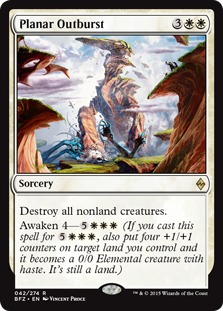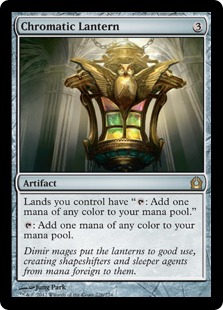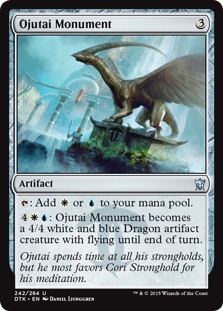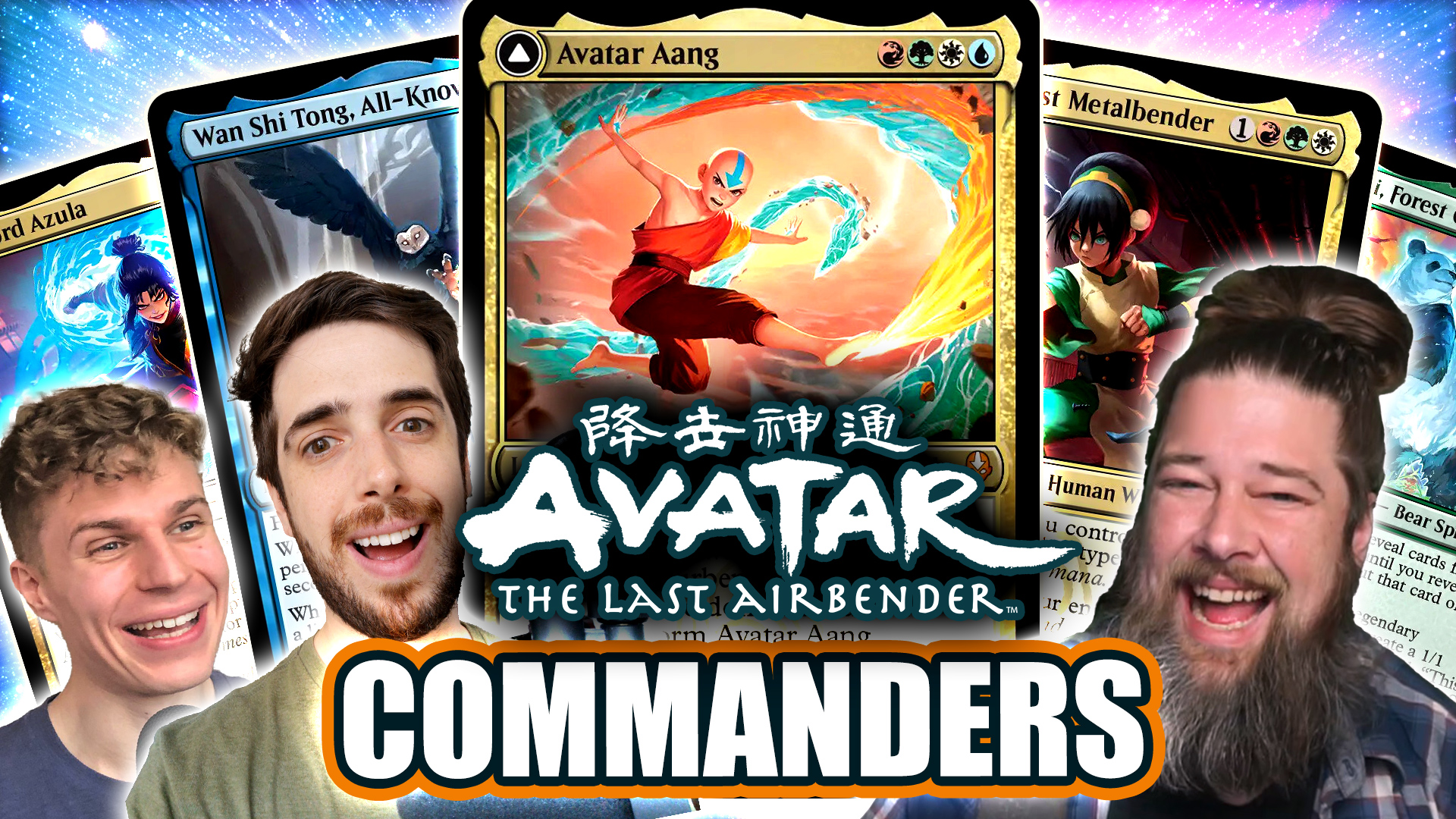Seer's Lantern and the Recent History of 3CMC Mana Rocks in Standard
Getting the opportunity to write a spoiler article is by far one of the coolest Magic-related things ever to happen to me, so a huge thanks for Wizards for hooking us up with a brand new, never-seen-before Oath of the Gatewatch card to share with all of you today! I've always hated those spoiler articles that make you read a bunch of nonsense before getting to see the new card, so let's get this out of the way right off the bat: presenting Seer's Lantern!

So what we have here is a three-mana mana rock with upside. At first I was put off by the fact that Seer's Lantern only produces colorless mana, but in the brave new world of Oath of the Gatewatch, this might actually end up being an upside. Sure, producing one-mana of any color like Darksteel Ingot is great, unless you want to activate a Mirrorpool or cast a Kozilek, the Great Distortion, then you'll be wishing your Darksteel Ingot was a Seer's Lantern. Of course, for the immediate future we have the painlands from Magic Origins as the easiest and best way to make colorless mana, but once these cards rotate in the fall, Seer's Lantern could be very important to the format.
So is this card constructed playable? To answer that we'll look back over the recent history of three-CMC mana rocks in Standard.
Is Seer's Lantern Constructed Playable?

The upside of Seer's Lantern is similar to Crystal Ball, which saw extremely fringe play while it was Standard legal. Obviously the numbers are reversed; instead of scrying two for one-mana like Crystal Ball, Seer's Lantern scrys one for two-mana. But remember, we aren't playing Seer's Lantern for the scry — we're playing Seer's Lantern for the mana production. The upside of doing something when you are flooded out in the late game is important to the playability of the card. Assuming you have some left over mana sitting around, it doesn't take too many activations of Seer's Lantern for it to become better than Mind Stone's "sac to draw a card" ability. This is the biggest benefit of Seer's Lantern.
Imagine you are in a control mirror and looking to get down an Ob Nixilis Reignited on turn four. You play your Seer's Lantern on turn three, play your Ob Nixilis Reignited on turn four, and then what? Most mana rocks lose their utility as the game goes on and the amount of mana you have access to increases, but not Seer's Lantern. There's a strong argument that Seer's Lantern is even better in the late game where the scry one will make sure you keep drawing action while your opponent draws useless lands. Have you ever watched a Twin mirror in Modern? Typically, the first person to get a Desolate Lighthouse online will win the game because their average draw is so much better than their opponent's. I can imagine control mirrors in Standard being similar, where whoever gets into a position to scry every turn with Seer's Lantern first will likely win the game.


I'm pretty sure that a dedicated ramp deck (i.e. one that it trying to get to 10+ mana to cast Ulamog, the Ceaseless Hunger, Kozilek, the Great Distortion or Part the Waterveil) has better options than Seer's Lantern. In my experience with these decks, the goal is to go from two-mana, to four-mana, to six-mana, to 10-mana. Seer's Lantern ends up being at a very odd and inefficient place on the curve. On the other hand, I can picture dedicated control decks wanting to go from three-mana to five-mana, not only for planeswalkers like Ob Nixilis Reignited, but for the ability to turn Planar Outburst into Wrath of God. In some matchups, having a turn four wrath (instead of a turn five wrath) is a pretty big deal, and Seer's Lantern is the perfect card to facilitate this play.
I'll admit that when I first saw Seer's Lantern I wasn't overly impressed. My first impression was that it was another in a long line of mediocre three-mana mana rocks. However, I'm not the type to take my initial impression as the truth, so of course I did some research on the recent history of three-CMC mana rocks in Standard to try to figure out just how playable they really are. While none of these cards are exactly the same as Seer's Lantern, they are similar enough that we can use them to help judge Seer's Lantern's potential in tournament Magic.
1. Pristine Talisman

Easily the most played three-cmc mana rock of recent years is Pristine Talisman. When we ran a search of decks in the MTGGoldfish database containing three-cmc mana rocks over the past several years of Standard, we came up with a total 3,578. Of these, more than 2,200 were running Pristine Talisman. More than 60 percent of the play seen by all three-cmc mana rocks in our sample is attributable to this one card!
So what made Pristine Talisman a Standard staple? I mean, it looks a lot like Seer's Lantern, costing three-mana and tapping for one colorless. The key here is the incidental life gain. While the main purpose of the card was to ramp into extremely powerful control finishers like Elesh Norn, Grand Cenobite and Sun Titan, it was the lifegain, one-by-one, turn-by-turn, that kept these slow control decks alive in a fairly aggressive Standard format.

So how does paying two to scry one compare to gaining one life each turn? I believe it really depends on a matchup and the metagame. Assuming we are playing a control deck, which seems to be the most likely home for Seer's Lantern, in any aggressive matchup gaining life is far better than scrying. In fact, if we play a Seer's Lantern deck against something like Atarka Red, it's doubtful we'll ever find enough time to activate the scry ability. On the other hand, if we run into a midrange or control deck, being able to scry repeatedly in the late game is typically going to be better than gaining a bit of life here and there. Imagine we are going up against Esper Dragons. How often is gaining one life a turn going to be relevant? Not very. On the other hand, leaving up countermagic and scrying when we don't have to cast a counterspell has potential to win a lot of games.
I think it's ambitious to expect Pristine Talisman-levels of play from Seer's Lantern. None of the other three-cmc mana rocks printed over the past few years have even come close, but the fact that there are some matchups where we'd rather have Seer's Lantern than a Pristine Talisman does bode well for the card's playability.
2. Rakdos and Selesnya Keyrune


While all of the members of the keyrune cycle saw at least a little bit of play during their time in Standard, it was Rakdos Keyrune and Selesnya Keyrune that came out the big winners. Rakdos Keyrune in specific saw a ton of play, with just about 900 decks showing up in the MTGGoldfish database (meaning 25 percent of all three-cmc mana rock comes from Rakdos Keyrune). This, however, was more of a product of the format than a testament to the power of Rakdos Keyrune itself. For the first year of Rakdos Keyrune's life, we were living in a Standard format utterly dominated by Thragtusk. It just so happens that a 3/1 with first strike is a very good way to keep from dying to a 5/3 and the 3/3 token it leaves behind. While it is difficult to draw a direct comparison between any of the Keyrunes and Seer's Lantern (keyrunes tap for two colors of mana and can turn into creatures), I think the main takeaway here is that the playability of a three-cmc mana rock is highly dependent on the metagame.

Rakdos Keyrune (and to a lesser extent, Selesnya Keyrune) was very good in its respective Standard format because it matched up well with Thragtusk, while also providing the mana necessary to ramp into Thragtusk and Rakdos's Return, as well as activate Olivia Voldaren. While Seer's Lantern is never going to stonewall a creature, it does have some pretty powerful colorless creatures to ramp into, but the real question is just how good will scry one be in Standard?
Obviously it will be better if the format is slow and more controlling, so it seems unlikely to be very good immediately. Until April rotation, Standard will still have Atarka Red, it will still have super efficient four-and five-color decks built around the fetchland manabase, and it will still have Mantis Rider and Siege Rhino. However, once rotation hits, it seems probable that the format will slow down considerably. Instead of super efficient wedge cards, many of the most powerful cards in Standard will be huge, colorless Eldrazi from Battle for Zendikar and Oath of the Gatewatch. It is in this environment that Seer's Lantern could have a chance to shine, as a way to ramp into an Eldrzi and then eat up additional, useless mana on subsequent turns.
3. Chromatic Lantern

After Pristine Talisman and Rakdos Keyrune, there is a huge drop off to the number three three-cmc mana rock, Chromantic Lantern. While Pristine Talisman showed up in thousands of decks, and Rakdos Keyrune showed up in almost a thousand, Chromantic Lantern shows up in a grand total of 90, mostly four- or five-color decks which leaned heavily on the "lands you control can tap for any color of mana" ability. On its face, it's difficult to compare an "any color" mana rock like Chromantic Lantern to a "colorless" mana rock like Seer's Lantern, but I think there is one thing we can glean from trying. Some three-cmc mana rocks, while not good enough to be jammed in every deck, are very good if you are playing one specific archetype. For Chromantic Lantern, this is four/five color decks, for Seer's Lantern this might end up being control decks (that can take advantage of the scry ability) or decks that really need colorless mana (especially in a post-painland world this fall). So even though not everyone will want Seer's Lantern in their deck, there is a fairly good chance that someone will.

Not Quite Good Enough
We've been talking about mana rocks that were successful and playable in their Standard formats, but in the name of fairness, I should also mention the recent three-cmc mana rocks that didn't end up seeing much play at all. While all of these cards saw play in the strictest sense of the term (they show up in between 1 and 10 decks in the MTGGoldfish database), for all intents and purposes they didn't have a place in their Standard formats. So the questions are, why not, and how does Seer's Lantern compare to these cards?

Let's start with Darksteel Ingot, which has two major problems. First, it doesn't really have an upside (being indestructible isn't relevant most of the time), and second, it was released right before the devotion-themed Theros set. As a result, for pretty much the entire time Darksteel Ingot was in Standard, the format was dominated by mono-colored decks like Mono-Black and Mono-Blue Devotion. As a result, tapping for one-mana of any color wasn't really an upside in the format. Plus, decks like Mono-Blue Devotion were fast enough that the big control deck in the format — Esper Control with Sphinx's Revelation — couldn't afford to tap out for a do-nothing artifact on turn three. I'm fairly confident that Seer's Lantern will be better than Darksteel Ingot because tapping for colorless will mean more in Oath of the Gatewatch Standard than tapping for any color in Theros Standard. Plus, it has more upside thanks to the scry ability.


We might as well lump the Cluestones and the Banners together because they are very similar. Each taps to add mana for its respective guild or wedge, and each can be sacrificed to draw a card by paying one-mana of each color it produces. As for why these cards didn't see play in Standard, I think the best explanation is that their formats were either too fast and efficient (Khans Standard) or too mono-color focused (Theros Standard). Once again, Seer's Lantern seems better than either of these cycles. We've already talked about how the format will likely slow down once Khans block rotates in April, and slow formats are more welcoming to three-cmc mana rocks. Plus, being able to scry one repeatedly is far more valuable in a long game than simply sacrificing to draw a card outright. There was a big debate about how much "scry one" is actually worth when the scrylands were released in Theros, and I think the general consensus was scry one was equivalent to drawing half a card. After two activations, Seer's Lantern produces value equal to a Cluestone or Banner (and remains on the battlefield), and after three or more activations is has produced more value than a Banner or Cluestone.



Finally, we have the Monument cycle from Dragons of Tarkir. While they have a fairly impressive upside by turning into 4/4 flying creatures, the big problem here is that the activation cost is just far too high. Six-mana is almost always your entire turn, so if your opponent has a removal spell, you basically end up time walking yourself. At least with Seer's Lantern, the activation is only two-mana, and unlike a Monument, you can sit on a counterspell and scry one on your opponent's end step.
The Verdict
Overall, I expect Seer's Lantern to fall somewhere in the Chromatic Lantern range. It's hard for me to imagine it reaching Pristine Talisman levels of play, or being an important role player like Rakdos Keyrune, but I think there will be a deck or two that really wants it (mostly likely a control deck, or a deck that really values its ability to produce colorless mana). This said, much will depend on what our future Standard format looks like. The more play colorless cards see and the slower the format is, the more play Seer's Lantern will see. On the other hand, if Shadows over Innistrad picks up where Khans block left off and pushes Battle for Zendikar block to the fringes of the format, there might not be much of a reason to play any three-cmc mana rock, including Seer's Lantern. So while I think Seer's Lantern has enough upside to potentially see play, as with all freshly spoiled cards, much will depend on what cards end up around it and how the metagame shakes out.
Conclusion
Anyway, that's all for today. Leave your thoughts, ideas, options, and suggestion in the comments, and as always you can reach me on Twitter (or MTGO) @SaffronOlive.













